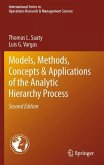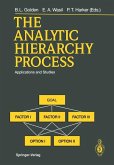Models, Methods, Concepts and Applications of the Analytic Hierarchy Process is a volume dedicated to selected applications of the Analytic Hierarchy Process (AHP) focused on three themes: economics, the social sciences, and the linking of measurement with human values. (1) The AHP offers economists a substantially different approach to dealing with economic problems through ratio scales. The main mathematical models on which economics has based its quantitative thinking up to now are utility theory, which uses interval scales, and linear programming. We hope that the variety of examples included here can perhaps stimulate researchers in economics to try applying this new approach. (2) The second theme is concerned with the social sciences. The AHP offers psychologists and political scientists the methodology to quantify and derive measurements for intangibles. We hope that the examples included in this book will encourage them to examine the methods of AHP in termsof the problems they seek to solve. (3) The third theme is concerned with providing people in the physical and engineering sciences with a quantitative method to link hard measurement to human values. In such a process one needs to interpret what the measurements mean. A number is useless until someone understands what it means. It can have different meanings in different problems. Ten dollars are plenty to satisfy one's hunger but are useless by themselves in buying a new car. Such measurements are only indicators of the state of a system, but do not relate to the values of the human observers of that system. AHP methods can help resolve the conflicts between hard measurement data and human values.








